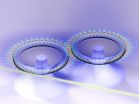The tsunami was at least three times the size of a 1946 tsunami that was the most destructive in Hawaii's recent history, according to the new study that examined deposits believed to have come from the extreme event and used models to show how it might have occurred. Tsunamis of this magnitude are rare events. An earthquake in the eastern Aleutian Trench big enough to generate a massive tsunami like the one in the study is expected to occur once every thousand years, meaning that there is a 0.1 percent chance of it happening in any given year – the same probability as the 2011 Tohoku earthquake that struck Japan, according to Gerald Fryer, a geophysicist at the Pacific Tsunami Warning Center in Ewa Beach, Hawaii.
Nevertheless, the new research has prompted Honolulu officials to revise their tsunami evacuation maps to account for the possibility of an extreme tsunami hitting the county of nearly 1 million people. The new maps would more than double the area of evacuation in some locations, according to Fryer.
"You're going to have great earthquakes on planet Earth, and you're going to have great tsunamis," said Rhett Butler, a geophysicist at the University of Hawaii at Manoa and lead author of the new study published online in Geophysical Research Letters, a journal of the American Geophysical Union. "People have to at least appreciate that the possibility is there."
Hawaiians have told stories about colossal tsunamis hitting the islands for generations, but possible evidence of these massive waves was only first detected in the late 1990s when David Burney, a paleoecologist at the National Tropical Botanical Garden in Kalaheo, was excavating the Makauwahi sinkhole, a collapsed limestone cave on the south shore of Kauai.
Two meters (six and a half feet) below the surface he encountered a layer of sediment marked by coral fragments, mollusk shells and coarse beach sand that could only have come from the sea. But the mouth of the sinkhole was separated from the shore by 100 meters (328 feet) of land and seven-meter (23-foot) high walls. Burney speculated that the deposit could have been left by a massive tsunami, but he was unable to verify the claim.
The deposits remained a mystery until the Tohoku earthquake hit Japan in 2011. It caused water to surge inland like a rapidly rising tide, reaching heights up to 39 meters (128 feet) above the normal sea level. After that tsunami deluged the island nation, scientists began to question Hawaii's current tsunami evacuation maps. The maps are based largely upon the 1946 tsunami, which followed a magnitude 8.6 earthquake in the Aleutian Islands and caused water to rise only two and a half meters (8 feet) up the side of the Makauwahi sinkhole.
"[The Japan earthquake] was bigger than almost any seismologist thought possible," said Butler. "Seeing [on live TV] the devastation it caused, I began to wonder, did we get it right in Hawaii? Are our evacuation zones the correct size?"
To find out, the study's authors used a wave model to predict how a tsunami would flood the Kauai coastline. They simulated earthquakes with magnitudes between 9.0 and 9.6 originating at different locations along the Aleutian-Alaska subduction zone, a 3,400-kilometer (2,113-mile) long ocean trench stretching along the southern coast of Alaska and the Aleutian Islands where the Pacific tectonic plate is slipping under the North American plate.
The researchers found that the unique geometry of the eastern Aleutians would direct the largest post-earthquake tsunami energy directly toward the Hawaiian Islands. Inundation models showed that an earthquake with a magnitude greater than 9.0 in just the right spot could produce water levels on the shore that reached eight to nine meters (26 to 30 feet) high, easily overtopping the Makauwahi sinkhole wall where the ocean deposits were found.
The authors used radiocarbon dated marine deposits from Sedanka Island off the coast of Alaska and along the west coasts of Canada and the United States that date back to the same time period as the Makauwahi deposit to show that all three sediments could have come from the same tsunami and provide some evidence that the event occurred, according to the study.
"[The authors] stitched together geological evidence, anthropological information as well as geophysical modeling to put together this story that is tantalizing for a geologist but it's frightening for people in Hawaii," said Robert Witter, a geologist at the U.S. Geological Survey in Anchorage, Alaska who was not involved in the study.
According to Witter, it is possible that a massive tsunami hit Hawaii hundreds of years ago, based on the deposits found in the Kauai sinkhole, but he said it is difficult to determine if all three locations experienced the same event based on radiocarbon dating alone.
Radiocarbon dating only gives scientists a rough estimate of the age of a deposit, he said. All three locations offer evidence of a great tsunami occurring between 350 and 575 years ago, but it is hard to know if it was the same tsunami or ones that occurred hundreds of years apart.
"An important next thing to do is to look for evidence for tsunamis elsewhere in the Hawaiian island chain," said Witter.
Fryer, of the Pacific Tsunami Warning Center, is confident that more evidence of the massive tsunami will be found, confirming that events of this magnitude have rocked the island chain in the not-so-distant past.
"I've seen the deposit," said Fryer, who was not involved in the study. "I'm absolutely convinced it's a tsunami, and it had to be a monster tsunami."
Fryer is so convinced that he has worked with the city and county of Honolulu to update their tsunami evacuation maps to include the possibility of a massive tsunami the size of the one detailed in the new study hitting the islands. The county hopes to have the new maps distributed to residents by the end of the year, he said.
"We prepared ourselves for the worst tsunami that's likely to happen in one hundred years," Fryer said of the current tsunami evacuation maps based on the 1946 event. "What hit Japan was a thousand-year event ... and this scenario [in the eastern Aleutians] is a thousand year event."
INFORMATION:
The American Geophysical Union is dedicated to advancing the Earth and space sciences for the benefit of humanity through its scholarly publications, conferences, and outreach programs. AGU is a not-for-profit, professional, scientific organization representing more than 62,000 members in 144 countries. Join our conversation on Facebook, Twitter, YouTube, and other social media channels.


